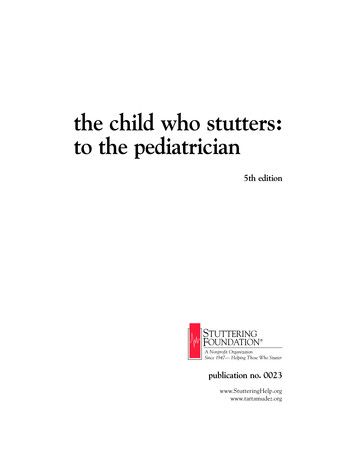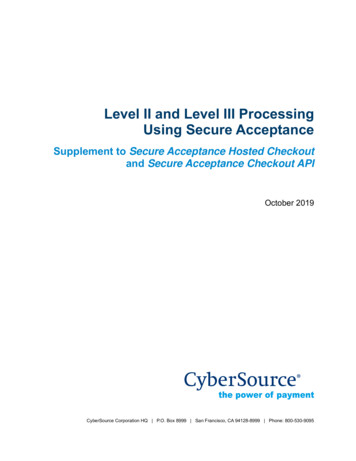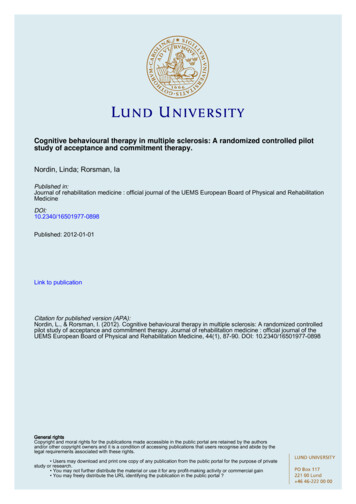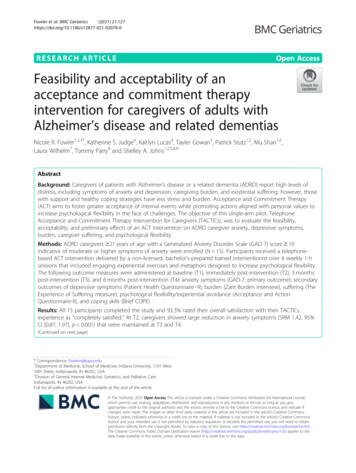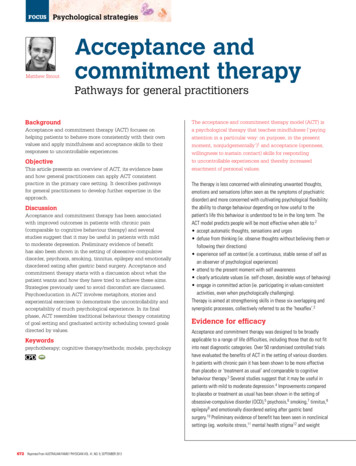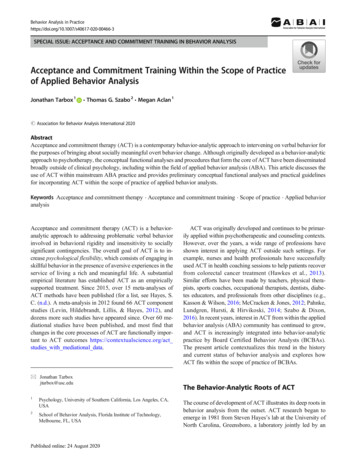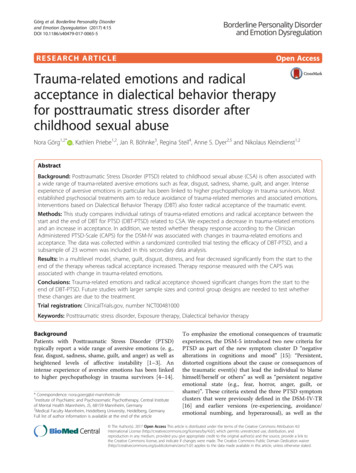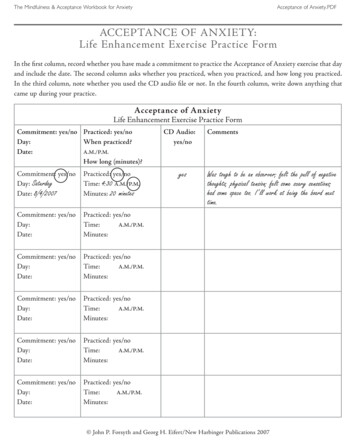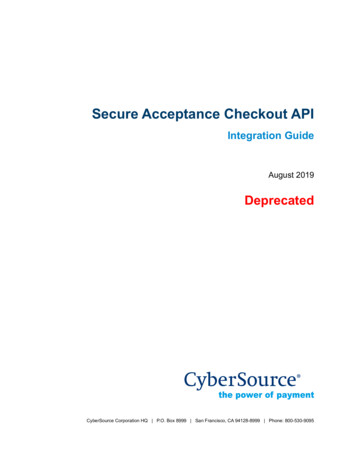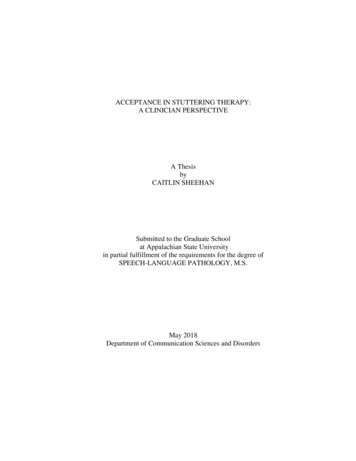
Transcription
ACCEPTANCE IN STUTTERING THERAPY:A CLINICIAN PERSPECTIVEA ThesisbyCAITLIN SHEEHANSubmitted to the Graduate Schoolat Appalachian State Universityin partial fulfillment of the requirements for the degree ofSPEECH-LANGUAGE PATHOLOGY, M.S.May 2018Department of Communication Sciences and Disorders
ACCEPTANCE IN STUTTERING THERAPY:A CLINICIAN PERSPECTIVEA ThesisbyCAITLIN SHEEHANMay 2018APPROVED BY:Joseph KleinChairperson, Thesis CommitteeKim McCulloughMember, Thesis CommitteeAngela LosardoMember, Thesis CommitteeGail DonaldsonChairperson, Department of Communication Sciences and DisordersMax C. Poole, Ph.D.Dean, Cratis D. Williams School of Graduate Studies
Copyright by Caitlin Sheehan 2018All Rights Reserved
AbstractACCEPTANCE IN STUTTERING THERAPY:A CLINICIAN PERSPECTIVECaitlin SheehanB.S., Appalachian State UniversityM.S., Appalachian State UniversityChairperson: Joseph KleinThe present study explores the concept of stuttering acceptance by examining thepoint of view of speech-language pathologists who treat people who stutter. Three mainquestions were posed: 1) How do speech-language pathologists define acceptance in regardsto stuttering? 2) Is acceptance of stuttering important in therapy, and why is it important? 3)How is acceptance of stuttering addressed in therapy? In interviewing six therapists that workspecifically with clients who stutter, stuttering acceptance was identified as beingmultifaceted and vital to the ultimate success of therapy for those who stutter. Eachparticipant shared how they address acceptance of stuttering in therapy. The results of thisstudy clarified the concept of acceptance in stuttering therapy from the clinician perspectivein addition to providing a basic, positive therapeutic framework for clients who stutter acrossthe lifespan. Findings indicate that acceptance of stuttering involves clients’ (1)understanding that stuttering and its management is variable, (2) being able to toleratemoments of stuttering, and (3) having a positive self-perception.iv
Table of ContentsAbstract . ivIntroduction .1Literature Review.1Method .9Participants .10Materials & Procedure .10Credibility .10Analysis.11Results .13Conclusion .18References .19Appendix A: Participant Questionnaire .23Appendix B: Interview Questions .24Vita.25v
IntroductionIn a call for treatment research, Nippold (2011) noted a trend in the stuttering therapyliterature towards counseling children to accept their stuttering, thereby “throwing in thetowel on the effort to achieve fluency in school-age children” (99). In a letter to the editor,Yaruss, Coleman, and Quesal (2012) responded that stuttering is a multidimensional disorderrequiring multiple goals, including acceptance, that can be selected for each person’sindividual needs. It is unclear at this time, however, what the beliefs of practicing cliniciansare regarding the use of acceptance in stuttering therapy. The purpose of this study is todetermine what speech-language pathologists who primarily treat people who stutter believeacceptance means and to what extent acceptance plays in the management of stuttering. Inaddition, this study aims to identify how acceptance is addressed in therapy and whatoutcomes are typically realized.Literature ReviewStuttering involves interference in the forward flow of speech, in the form ofdisruptions such as repetitions, blocks, and prolongations of sound. As a result, those whostutter often experience physical tension and loss of control while speaking (Yaruss, 2004).Those who stutter are faced with feelings of anxiety, frustration, and shame; not only becauseof the associated communicative difficulties faced from a young age, but also because of thestigma attached to stuttering. Often, the impact of stuttering leads to pervasive avoidancebehavior and negative feelings and attitudes surrounding speaking situations (Pollard, 2012).Stuttering affects one’s self-image, relationships, and employment. Klein and Hood(2004) found that those who stutter often consider their stuttering to be a handicap in thepursuit of their true calling. Many consumers and speech-language pathologists believe that1
fluency is the primary goal of therapy for people who stutter, and that those who stuttershould work diligently to become fluent. However, the reality is that total fluency is often nota possibility when treating and managing complex disorders such as stuttering. The role ofthe speech-language pathologist necessitates that therapeutic measures are tailored to theconsumer, taking into account the consumer’s needs and desires.In simplest terms, acceptance is the action or process of being regarded as adequate orsuitable. For those who stutter, acceptance follows when resistant behaviors, attitudes, andcognitions surrounding their stutter are shed; in turn, negative appraisals and avoidancebehaviors diminish (Pollard, 2012). Acceptance does not imply that an individual shouldeither embrace or ignore difficulties related to stuttering, rather it entails an individual’swillingness to recognize and experience a difficulty and address it in a neutral or positivemanner (Yaruss, Coleman, & Quesal, 2012).The term acceptance carries with it positive, neural, and/or negative connotations, andvaries in meaning from person to person. It is important to recognize that clinicians may havea different concept of acceptance than a client, and across clients that concept may vary evenfurther. While the idea of acceptance in the literature often generates feelings of positivity, inreality the word may feel congruent with tolerating one’s stuttering or even giving up onworking towards more fluent speech. This view might lend to the assumption that in theprocess of counseling clients to accept their stuttering, a clinician abandons treatment gearedtowards speech. Many professionals, however, have concluded that stuttering is amultifaceted disorder that impacts each individual differently, necessitating a comprehensiveapproach to treatment that addresses the needs of the client (Yaruss et al., 2002). Thus,depending on the individual, treatment may indeed involve working to increase fluency,2
while also allowing the client to move towards acceptance simultaneously. One’s concept ofacceptance often changes over time as well, which parallels the process of acceptance itself –it is not a means to an end, rather it is a state of being. It is the clinician’s duty to emphasizethat acceptance is not giving up, rather it is giving up the active struggle against the problem.It is demanding and challenging work for the consumer, but it is highly beneficial. De Nardo,Gabel, Tetnowski, and Swartz (2016) found that there is a significant positive correlationbetween self-acceptance and self-esteem. In addition, participants that believed their therapyoutcomes to be successful were much more likely to report higher levels of self-acceptance.Stuttering is complex and involves more than just observable dysfluencies; those whostutter often experience negative affective, behavioral, and cognitive reactions that impactone’s ability to participate in daily activities. The World Health Organization (WHO)International Classification of Functioning, Disability and Health (ICF) is a framework usedto describe and organize information on both functioning and disability. The ICF allows for adescription of health that encompasses body function and structure, activities andparticipation, environmental factors, and personal factors (WHO, 2001). Yaruss and Quesal(2004) concluded that the ICF is effective in describing stuttering, as it examines both theinternal and external factors that may impact a person who stutters and can include bothfacilitating factors (e.g., a positive speech therapy experience) and hindering factors (e.g.,negative responses to one’s stuttering). In this way, the ICF demonstrates that stuttering ismultifaceted and greatly influences quality of life.Yaruss and Quesal (2006) later designed a tool based on the theoretical framework ofthe ICF called the Overall Assessment of the Speaker’s Experience of Stuttering (OASES) inorder to collect additional information regarding the outcomes of stuttering treatment from3
the perspective of the speaker and his or her experience as a person who stutters. Thismeasurement tool incorporates questions regarding (a) general perspectives about stuttering,(b) affective, behavioral, and cognitive reactions to stuttering, (c) functional communicationdifficulties, and (d) impact of stuttering on the speaker’s quality of life. The OASES adheresto the tenets of evidence-based practice while allowing clinicians and researchers to glean amore thorough evaluation of the outcomes of stuttering treatment beyond just the observableaspects of an individual’s speech. Much of the existing literature on stuttering focuses ontreating observable moments of stuttering, whereas the OASES examines factors that impactan individual’s quality of life, including perceptions of oneself and the world around them.Research regarding acceptance in those who stutter is limited. However, the availableliterature and anecdotal evidence indicates that there may be great value in utilizing theconcept of acceptance in the management and treatment of stuttering. One goal of integratingacceptance into treating and managing stuttering is to allow a client to lessen or eveneliminate their aversion to stuttered speech. Actively fighting against stuttered speech tensesthe articulators and heightens autonomic arousal, exacerbating stuttering (Pollard, 2012).Acceptance serves to minimize tension, avoidance behavior, and other negative experiencesthat result from an individual’s active attempt to evade stuttering.It is important to note that consumers who report successful management stutteringdo not report absolute fluency. Plexico, Manning, & DiLollo (2005) found that those whochange their former approach to themselves and their abilities as a person who stutters are themost successful in managing their stuttering. With the assistance of clinicians and/or lovedones, individuals take responsibility for the process of change and alter their view ofthemselves through the process of acceptance. This is not to say, however, that all clients4
who stutter will desire this model of management. In a survey examining the desire forfluency versus freedom from the perceived need to be fluent, Venkatagiri (2009) found thateight percent more of the total 216 respondents desired fluency. However, participants thatchose freedom over fluency were far more consistent in responses and overwhelmingly optedfor freedom in the situations and concepts presented in the survey questions. This suggeststhat even those who chose fluency as their overarching goal seek a balance between fluencyand freedom.While most clients who stutter desire acceptance to be at least part of their therapy,what therapeutic techniques are most helpful to achieve that goal? Murphy, Yaruss & Quesal(2007) found that activities relating to self-acceptance, such as learning about stuttering,exploring the moment of stuttering, positive self-talk, and learning about other people whostutter, allowed clients to both reduce sensitivity to stuttering and be more open about speechdifficulties. As treatment went on, success as a result of these therapy activities was apparentin the way clients perceived stuttering and an increased willingness to participate in speakingactivities.Acceptance and Commitment Therapy (ACT) is another technique used to increaseclient’s acceptance of stuttering. ACT focuses on reducing experiential avoidance, which isparticularly applicable to those who stutter, given the natural inclination to evade stressfulsituations related to speaking. People utilizing avoidance behavior attempt to escape orcontrol stressful situations, and often are not willing to address internal thoughts and feelings(Beilby & Byrnes, 2012). Although it is impossible to eliminate stressful situations, ACTserves to reduce the negative thoughts and feelings that people who stutter associate withtheir stuttered speech. ACT involves focusing on awareness, acceptance, and understanding5
one’s thoughts in order to increase psychological flexibility. Psychological flexibility isdefined as being present, open, and doing what matters to one’s self, which is accomplishedby utilizing the core principles of ACT, as outlined by Palasik and Hannan (2013). ACT hasthe potential to impact the ability of a person who stutters to manage both the physical andcognitive aspects of stuttering in a positive way, and potentially facilitate the application oftechniques meant to increase fluency (Palasik & Hannan, 2013). ACT is well-supported inthe psychology literature as a means to improve an individual’s quality of life. A metaanalysis performed in 2009 examining the effectiveness of ACT found that overall, theparticipant treated using ACT underwent more improvement than 66% of participants incontrol conditions (Powers, Zum Vörde Sive Vörding, & Emmelkamp, 2009).A review examining mindfulness training in stuttering management implied similarsuccessful outcomes. Mindfulness, the concept of focusing awareness of internal and externalexperiences on the present, without judgment, allows a person to acknowledge and acceptfeelings, thoughts, and bodily sensations (Boyle, 2011). This review did not include tangibleapplication of mindfulness in stuttering management. However, in applying the tenets ofmindfulness to stuttering management, Boyle (2011) posited that the decreased avoidance,increased regulation of emotion, and increased acceptance resultant of mindfulness help tomanage cognitive, affective, and behavioral challenges faced by those who stutter.Examining acceptance as it relates to other areas of research also speaks to the meritthat this approach has. For example, an open trial investigating the role that acceptance playsin treating Generalized Anxiety Disorder (GAD) found that an acceptance-based behaviortherapy focusing on self-awareness and self-compassion allowed for a reduction in symptomseverity and related avoidance behaviors lasting longer than previous forms of treatment6
(Roemer & Orsillo, 2007). Those affected by GAD, like those who stutter, are prone toutilizing avoidance behaviors as a mechanism to cope. The success of this acceptance-basedapproach in GAD treatment may indicate a similar level of success for use in stutteringtreatment.While the process of treating and managing stuttering may include various techniquesaddressing the tangible act of stuttering, the most comprehensive treatment approach willalso endeavor to reduce the negative impact of stuttering. A study examining the responses of71 participants at a National Stuttering Association convention found that those who hadparticipated in fluency-shaping treatments (techniques to alter breathing, speech rate, voiceproduction, and articulation to facilitate fluent speech) alone were more likely to report thatthey had experienced a relapse in stuttering than those who had participated in stutteringmodification (techniques to increase awareness of stuttered speech, examine and reducephysical tension, and change moments of stuttering to reduce struggle behaviors and stutterin a more relaxed way) or combined treatments.From a clinical standpoint, fostering acceptance in clients leads to growth; includingincreased fluency and improved attitudes about speaking and perception about oneself as acommunicator (Games, 2013). However, it is vital to understand that acceptance is notsomething that happens or does not happen; rather it is a continuous, lifelong process thatrequires support and guidance. In fact, the strongest predictors for acceptance of one’sdisability, whatever that disability may be, include emotional and social support from familyand peers, high self-esteem, and low perceived social discrimination (Li & Moore, 1998).These predictors can be promoted by speech-language pathologists by utilizing acceptancebased therapeutic techniques, as well as providing emotional and spiritual support. There is7
certainly an existential component involved in a client’s effort to manage stuttering, and it isimportant for the clinician to provide support as the client is undergoing more than justoutward change, they are facing an inner journey as well (Spillers, 2007). Attending to innerissues, such as the acceptance of one’s stuttering, ultimately enhances long-term outcomes oftreatment.Cheasman, Simpson, and Everard (2015) examined the literature and found thatorganizations, therapy groups, and even online communities play an important role inencouraging openness to stuttering by promoting recognition of stuttering as a sharedexperience rather than an individual problem. In this way, collective groups allow for a moreeffective shift from quietly struggling against stuttering to challenging stereotypes andprevalent negative stereotypes in a positive and public forum. When a structure of support isavailable to an individual, acceptance can be understood and obtained more readily.The concept of acceptance is not clearly defined as it relates to stuttering, as researchregarding this topic is limited and existing literature is recent. Stuttering affects not only thespeech aspect of communication, but the psychosocial aspect as well. Therefore, the conceptof acceptance is especially important to further explore. The current study investigates 1)how speech-language pathologists define acceptance in regards to stuttering, 2) why or whynot acceptance of stuttering is important in therapy, and 3) how acceptance of stuttering isaddressed in therapy. Qualitative data gathered from semi-structured interviews with speechlanguage pathologists with a stuttering client-base will serve to elucidate the definition ofacceptance and its role in therapy.8
MethodThis study utilizes a qualitative research design. Damico and Simmons-Mackie(2003, p. 132) define qualitative research as “a variety of analytic procedures designed tosystematically collect and describe authentic, contextualized social phenomena with the goalof interpretive adequacy.” Essentially, the goal of qualitative research is to effectivelydescribe and explain the essence of a social phenomenon in a methodical way. Additionally,qualitative research methods allow researchers to study questions of meaning, examineinstitutional and social practices and processes, identify barriers and facilitators to change,and ascertain reasons for the success or failure of interventions (Starks & Brown Trinidad,2007). There are several different approaches to qualitative research, including, but notlimited to, ethnographies, case studies, and phenomenological studies.The present study uses a phenomenological approach in order to understand theperspective of speech-language pathologists working with clients who stutter regarding theirdefinition, understanding, and application of acceptance in stuttering therapy.Phenomenology posits that those who experience a phenomenon, especially those whoobserve that same phenomenon frequently over time and in varied contexts, will be able toprovide the best description of that phenomenon (Moustakas, 1994 as cited in Plexico et al.,2005). Phenomenological research ultimately aims to identify the fundamental structure of aphenomenon and how it presents itself, which in this case involves identifying whatacceptance of stuttering is and how and why it is achieved (Valle & King, 1978, as cited inPlexico et al., 2005).9
ParticipantsThe present study received IRB exemption at Appalachian State University.Participants in the study included six speech-language pathologists whose client-baseconsists primarily of children and adults who stutter. Inclusion criteria necessitated thatparticipants (a) had been a practicing speech-language pathologist for at least 5 years, (b) hada client base that consists of at least 50% stuttering clients, (c) would be able and willing toprovide detailed descriptions of the phenomenon of acceptance in stuttering therapy.Materials & ProcedureParticipants were provided with a questionnaire consisting of six questions regardingdemographic information and information about their experience as a speech-languagepathologist. The questionnaire can be found in Appendix A. Following completion of thequestionnaire, the participants were individually interviewed via Zoom by the investigatorsusing six open-ended questions. Questions posed to the participants can be found inAppendix B. When interviews were conducted, they were video-recorded and transcribedverbatim. The transcripts were then analyzed separately by the investigators to identifythemes. Once the individual analyses were completed, the investigators compared theirfindings and came to a consensus.CredibilityIn order to address the reliability and objectivity of this study, methods described byCorcoran and Stewart (1998) were applied. Prior to conducting interviews, the primaryresearcher and her faculty adviser sought to explore and identify their personal andprofessional biases regarding acceptance and stuttering in order to reduce the impact thattheir own experiences and/or assumptions might have in the analysis of participant responses.10
In that way, the investigators endeavored to better understand the perspective of theparticipants without allowing their own preconceptions to interfere with the outcomes of thestudy.The primary investigator in this study is a fluent speaker with no history of stuttering,has a bachelor’s degree in communication sciences and disorders, and was a student enrolledin the second year of a speech-language pathology master’s degree program at the time of thestudy. She believes that to some degree, acceptance should play a role in all rehabilitativeservices. The second investigator, the faculty adviser, is a person who stutters, has a Ph.D. inspeech-language pathology, and had 13 years of experience in the area of fluency disorders atthe time of the study. He believes that acceptance plays an important role in therapy andquality of life for at least some clients who stutter.AnalysisAfter interviews were conducted and transcribed, the authors identified themes, whichserved as the primary data for analysis. This data was then organized into discrete categories.Using the constant comparative method proposed by Bogdan and Biklen (1998) as describedin Plexico et al. (2005), the data was analyzed inductively, taking into account: 1) individualexperiences, 2) recurring themes, and 3) essential structure.In order to identify individual experiences, the two investigators separately performedan analysis of each transcript, reading each transcript twice. The authors then noted theparticipant’s experiences and interpretations. These noted experiences and interpretationsoften represented more than one experience, and experiences frequently overlapped oneanother as well. These portions of text were then copied and pasted into an additionaldocument. In order to come to a consensus regarding what constituted as an individual11
experience, the authors reviewed the transcripts and subsequently noted experiences andinterpretations together.The investigators independently grouped individual experiences into themes. Theythen came together again to discuss these themes and come to a consensus regarding the mostsalient recurring themes across participants. Lastly, exhaustive descriptions of eachphenomenon were developed by integrating the participant’s individual experiences and thederived recurring themes and subsequently describing them explicitly. These descriptionsprovide an understanding of the essential structure of the studied phenomena. The caveat isthat this essential structure relies upon a limited sample size and a limited time period. Viewson acceptance in stuttering therapy may vary significantly beyond the participating clinicians.12
ResultsThe primary purpose of this study was to increase our understanding of stutteringacceptance by examining the point of view of therapists who treat people who stutter. Thepresent study poses three questions:1.How do speech-language pathologists define acceptance in regards to stuttering?2. Is acceptance of stuttering important in therapy, and why is it important?3. How is acceptance of stuttering addressed in therapy?Definition of AcceptanceEach participant had different responses regarding the definition of acceptance instuttering. However, the authors identified one overarching theme across participants:acceptance is multi-faceted, meaning that there is no one clear-cut definition for acceptance,as there are various factors and events that shape what it means for an individual at any giventime. While a concise, exact definition may be difficult to identify, the information derivedfrom the interviews informs the essential structure of acceptance in stuttering therapy.According to the six participants, stuttering acceptance as an overall concept involves1) acceptance of the inherent variability of stuttering, 2) the understanding that acceptance isan ongoing, nonlinear process 3) a positive self-perception, and 4) tolerance of the momentof stuttering.Acceptance of the variability of an individual’s stutter from day to day, or evenmoment to moment, is a vital piece of stuttering acceptance: “Acceptance includes theunderstanding that there will be good days and bad days, but that doesn’t reflect how hardyou did or didn’t work - stuttering is chronic.” In that same vein, the process of acceptance isvariable, ongoing, and nonlinear. Acceptance is not simply meeting a set goal of ‘being ok13
with stuttering.’ Rather, it includes multiple facets; understanding stuttering on a deeperlevel, understanding how other people view stuttering, being open to change, and acceptingboth the negative and positive aspects of stuttering. Collectively, the participants describedthe process of acceptance as being on a continuum. One participant described the process asfollows: “there are going to be ups and downs, and you’re likely going to question yourself attimes, but that is a part of acceptance.”A positive self-image, and acceptance of one’s self, appeared tantamount to acceptingthe nature of stuttering; “accepting oneself and the aspects of oneself other than identity as aperson who stutters is important.” A person’s perception of the people and world aroundthem is connected to how they might view themselves as a person, and as such, a person whostutters and is working towards acceptance of his or her stuttering needs to be able to acceptnot only the nature of stuttering, but also the environmental influences and internal/externalbiases that might affect self-worth. For example, one participant reported that “a client’sperception of how other people perceive their stuttering has a huge impact. The morenegatively a person who stutters perceives their stuttering as heard by others, the morenegatively they view their own stuttering.”Tolerating the moment of stuttering, and the physical and emotional components thatmay coexist, is also indelibly a part of stuttering acceptance. “Acceptance and tolerance ofthe moment induces change as a by-product.” In other words, if a person is utilizingavoidance behaviors and not actively working on stuttering acceptance during bonafidemoments of stuttering, “the intention is no different from before.”14
Is acceptance of stuttering important? Why?All six participants believed that acceptance of stuttering is important. However, asthere are clients who come into the therapy process without negative feelings and attitudestowards stuttering, acceptance does not necessarily need to be a primary focus of therapy forall clients. That being said, one participant identified stuttering acceptance as being “thefoundation for a lot of the changes that people want to make in their lives and in their speechand stuttering and communication in general.”Acceptance opens a person up to becoming an empowered communicator through theprocess of understanding and addressing the impact of stuttering rather than attempting toeliminate stuttering; “stuttering is so cyclical; life is different each day and thereforestuttering and subsequent reactions are different each day. Acceptance is important in
Acceptance and Commitment Therapy (ACT) is another technique used to increase client's acceptance of stuttering. ACT focuses on reducing experiential avoidance, which is particularly applicable to those who stutter, given the natural inclination to evade stressful
